Mazda CX-5 Akera Turbo review
Mazda delivers timely updates for its popular CX-5 mid-size SUV, ahead of the launch its all-new CX-60.
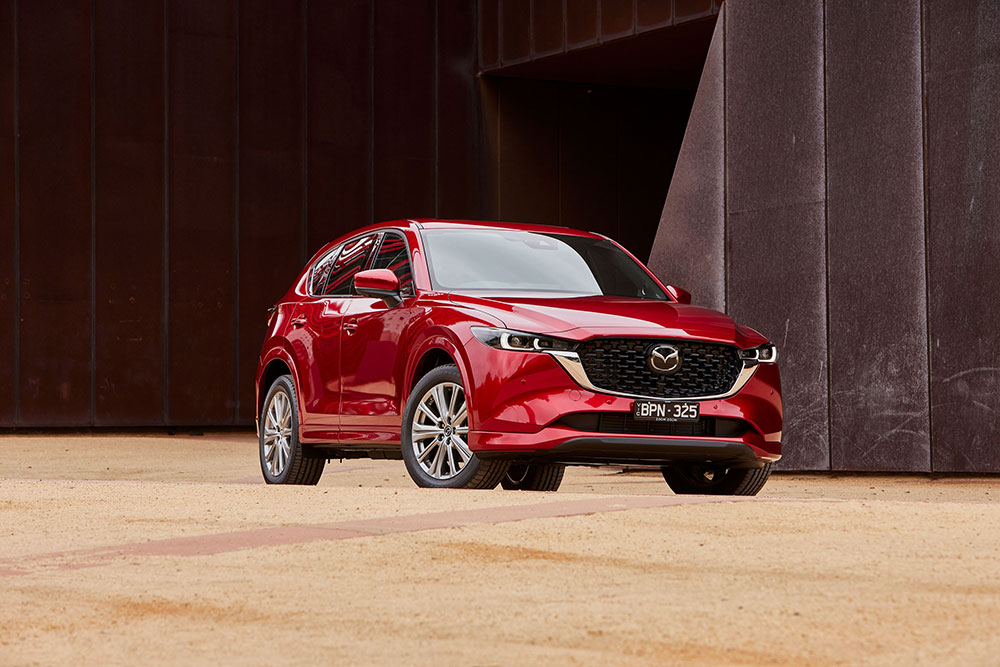
As other car makers grapple with supply chain issues that are pushing vehicle deliveries out by as much as 12 months, Japanese car maker Mazda finds itself in the happy position of having plenty of stock, short lead times and a freshly updated version of its popular CX-5 mid-sized SUV to take to market.
The facelifted CX-5 was launched to the media in South Australia’s Barossa Valley, with Mazda Australia Managing Director Vinesh Bhindi telling journalists the model remained one of Mazda’s most globally significant, accounting for more than over 3.5 million sales over the past decade.
Fully 230,000 of these sales have been in Australia, where Mazda enjoys market share above its global average and where the CX-5 was the number one selling SUV for seven consecutive years between 2013 and 2019.
Last year the Mazda ranked second behind the Toyota RAV4 in Australia’s critical medium-SUV segment with a healthy 24,968 sales.
This year, the vehicle that first brought Mazda’s ‘Kodo’ design language celebrates its 10th anniversary and to mark the occasion Mazda has endowed it with fresh looks, new features and more distinctive model grades.
It’s the latest of 10 different upgrades and refreshes for the CX-5 since it debuted in 2012, including a major styling update as recently as 2017.
The SUV segment shows no sign of slowing, according to Mr Bhindi, a fact that has prompted Mazda to push forward with the launch of a new mid-sized model later this year, designed to be complimentary to the CX-5.
The new Mazda CX-60 will boast similar proportions to the CX-5 but with an inline six-cylinder engine and rear-wheel drive layout, promises to be a more sporting and luxurious product.
A plug-in hybrid electric (PHEV) version will also reportedly be available.
Mazda executives are quick to dismiss suggestions the CX-60 will cannibalise sales of up-spec variants of the CX-5, pointing to the success of the complementary CX-3 and CX-30 and the brand’s eight-seat CX-8 and CX-9 models as examples of how adding additional models in the same category can grow overall market share.
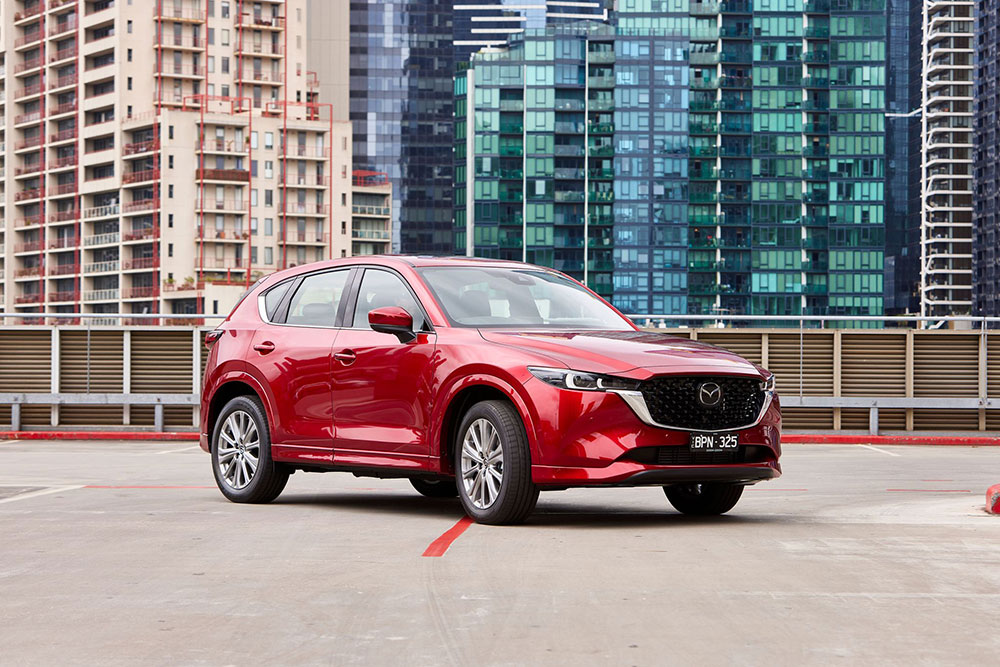
But right now, the CX-5 is the brand’s singular torch bearer in the medium-SUV category, this new version “stripping away the clutter and smoothing the surfaces”, in Mazda’s own words, to create a refreshed exterior look, with a bolder face that incorporates new headlights and grille.
Polished design remains a key part of Mazda’s appeal and this latest iteration of the CX-5 introduces a subtle but effective massaging of the proven formula.
The mid-size SUV’s basic proportions and underpinnings remaining untouched, but design changes at the front and rear differentiate it sufficiently from its predecessor.
Mazda describes the design changes as creating a more unified look, while at the same time more clearly distinguishing between the individual model grades, of which there are 12.
Changes include a revised front wing that extends further outward from the front grille, a new three-dimensional texture for the grille, plus revised head lights and taillights.
There’s also a new model dubbed the Touring Active that’s designed to appeal to sporty outdoor types, boasting a specific body kit and silver colour scheme on the front and rear bumpers and side garnish, and some unique interior design elements such as green accents on the air vents and seats.
There’s a raft of detail changes across the individual CX-5 models but all grades benefit from redesigned seats offering greater stability and better support.
There’s also a new Active Driving Display, a 7-inch TFT display in the gauge cluster, a new Sport and Off-Road Mode Mi-Drive switch on petrol AWD models, a configurable rear cargo area that enables the setting of a flat cargo floor and full LED headlamps and taillamps.
Among the engineering changes are improvements to the six-speed automatic transmission, designed to make it more responsive and refined; a more rigid body with improved dampening control; new headliner material to reduce low frequency sound; and petrol-powered models also get a new steering vibration countermeasure that improves steering refinement.
On a single day’s drive through the Adelaide Hills and Barossa Valley, the CX-5 reaffirmed that it is an accomplished and impressively refined mid-size SUV, that delivers a fine balance of performance, ride and handling.
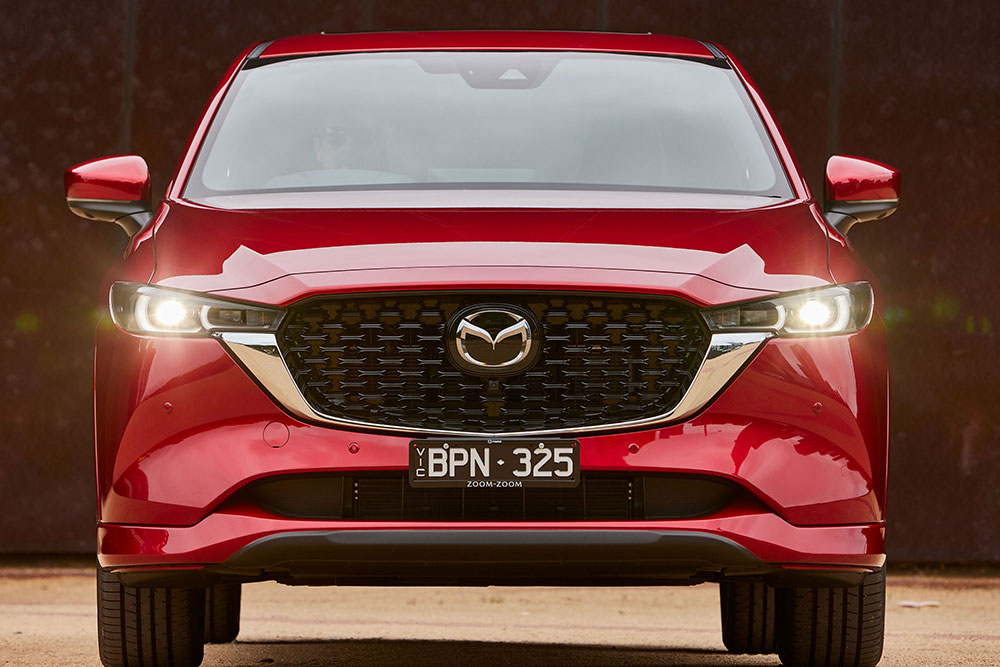
Now, as before buyers have a choice of turbo and non-turbo four-cylinder petrol engines, plus a single turbodiesel variant, with a six-speed manual available on the entry level Maxx FWD and other variants boasting a six-speed automatic.
Pricing starts at a reasonable $32,190 for the Maxx FWD (front-wheel drive) and climbs through 12 variants to the Akera Diesel AWD (all-wheel drive) priced at $53,680.
Entry-level models are powered by a direct-injection 2.0-litre four-cylinder petrol (115kW/200Nm), stepping up to a naturally aspirated 2.5-litre four-cylinder petrol (140kW/252Nm), a turbocharged petrol 2.5-litre four-cylinder (170kW/420Nm) and finally a 2.2-litre intercooled turbo diesel (140kW/450NM).
We drove only the better-specified, more powerful and more expensive GT SP Turbo and CX-5 Akera Turbo variants, both with all-wheel drive and priced at $51,290 and $53,180 respectively.
This pair no doubt put their best possible foot forward for the model range in terms of performance, features and comfort with combined turbo and non-turbo GT Sport and Akera variants accounting for 55% of total CX-5 sales.
The biggest selling single variant, however, is the non-turbo 2.5-litre CX-5 Maxx Sport, available in FWD and AWD, which accounts for 32% of sales.
The non-turbo 2.5-litre unit is also the engine of choice for some 63% of buyers, so would have been a more representative option to review, were we given the option.
In addition to the design changes already mentioned, the CX-5 Akera is further differentiated from its stablemates by way of smart-looking body colour painted wheel arch and lower body cladding, larger diameter twin exhaust tail pipes and upgraded Adaptive LED Headlamps, plus unique 19-inch alloy wheels finished in bright silver.
This well-appointed model now boasts wireless smartphone charging, a hands-free power tailgate and reversible floorboard setup in the cargo area. That’s in addition to what was an already generous level of standard equipment, including soft Nappa leather trim, ventilated front seats, heated outer seats in the second row, heated leather steering wheel, real wood door and dashboard trim inserts, frameless rear-view mirror and 7-inch TFT LCD multi-information meter display.
Cruising and Traffic Support is a newly added driver assistance feature and joins a long list of such standard safety features, including: autonomous emergency braking with night-time pedestrian detection, Dynamic Stability Control, Blind-Spot Monitoring, Driver Attention Alert, Emergency Stop Signal, Forward Obstruction Warning, Lane Departure Warning, Lane-Keep Assist System, Radar Cruise Control and Smart City Brake Support (forward/reverse).
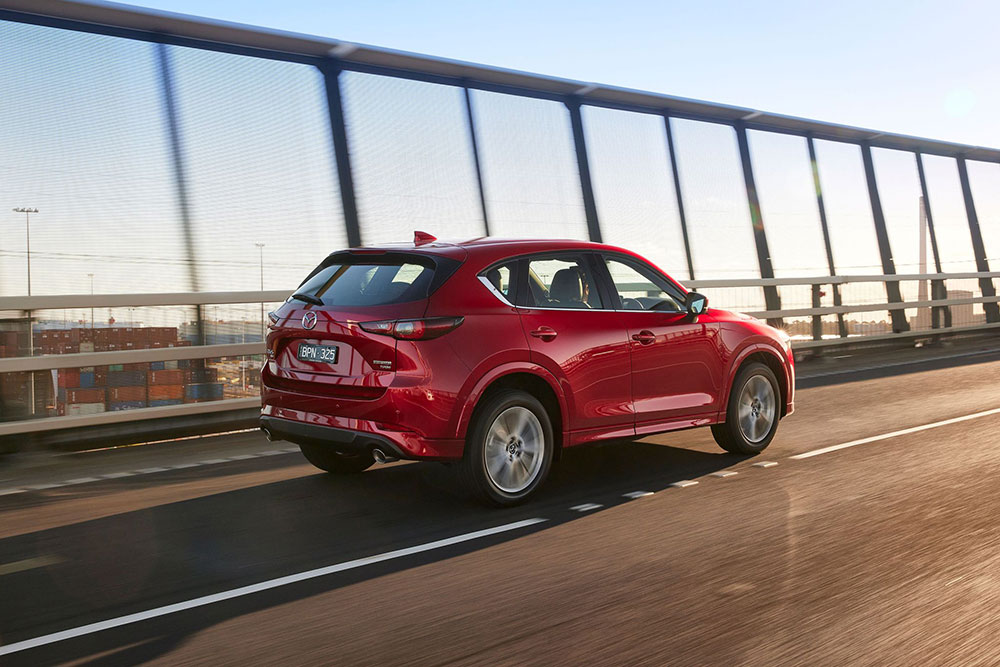
Other standard safety equipment includes front (driver and passenger), side
(front) and curtain (front and rear) airbags, all contributing to the CX-5’s continued hold on a five-star ANCAP ranking.
Mazda claims to have made numerous improvements to enhance handling, comfort, steering and dynamics, as well as further reducing NVH, but to be frank it’s been a long time between test drives of the CX-5, so we’re not able to comment on the efficacy of these changes.
Suffice to say that both the CX-5 Akera Turbo and the GT SP Turbo drive with impressive poise and polish.
Notable with either model is the smooth, fuss-free power delivery of the turbo four-cylinder.
This isn’t an engine that’s tuned for high performance histrionics, rather it’s designed to boost up early and maintain a nice flat torque curve which makes it feel almost diesel-like – albeit without the attendant noise and vibration.
The intercooled and turbocharged 2.5-litre engine produces a healthy 170kW/420Nm, which is a useful 30kW and 168Nm over the non-turbocharged version.
The extra performance does come at a cost, however, both via its $2500 higher list price and at the bowser, with the turbo sipping 91RON at rate of 8.2L/100km on the combined cycle or 1.2L/100km more than the non-turbo engine.
The six-speed automatic is responsive, refined and goes about its business without fuss, its shift aggressiveness able to be sharpened by selecting Sport mode via the Mi-Drive (Mazda Intelligent DriveSelect) system which also offers Normal, Off-Road, and Towing modes.
Rivals such as the Hyundai Tucson now offer eight-speed automatics on certain models, so in this regard at least the CX-5 no longer leads the pack.
Another area where the Mazda trails its Korean rival is in interior presentation and technology, with the CX-5 still using a conventional-looking instrument binnacle with analogue-style speedo and tacho.
There is a small 7-inch TFT display within the gauge cluster, but it stops short of the full digital dash setup found in the rival Hyundai Tucson and Kia Sportage.
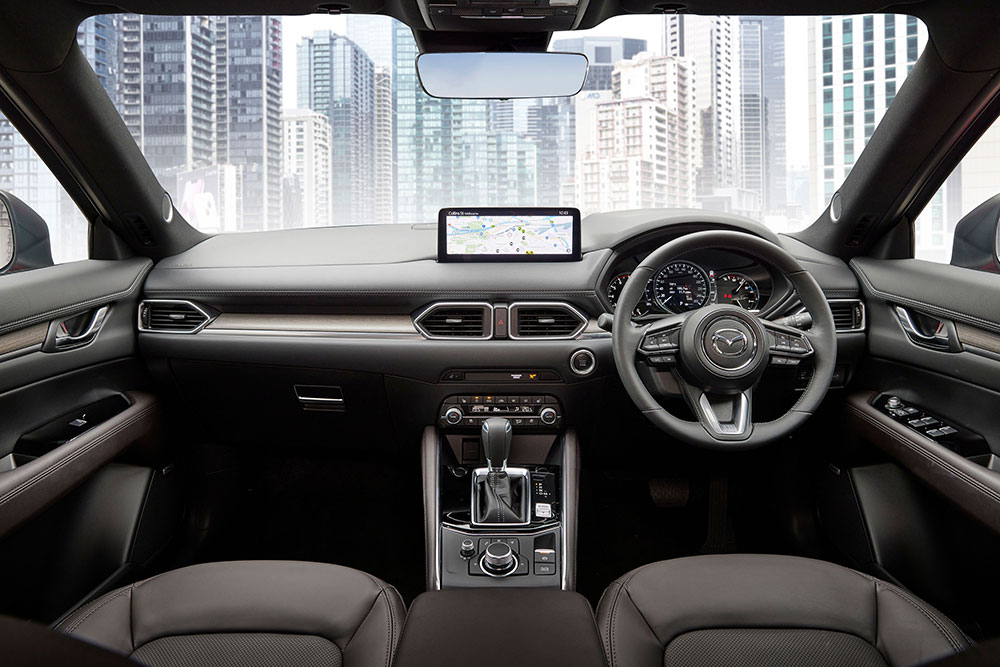
The CX-5 does have a central touchscreen through which its various menus are accessed and, while it’s perfectly up to the task, it lacks the wow factor of the larger screens in these models.
The addition of premium Nappa leather interior trim may assuage some concerns on this front with Mazda’s design, finish and materials quality as good or better than any of its rivals and the Akera further differentiated with standard features like a Premium Bose audio system with 249-watt amplifier and 10-speakers (including subwoofer).
Ride and handling are tuned to provide a comfortable and very competent driving experience.
While the CX-5 is clearly not designed to carve corners like an MX-5 sports car, the Mazda SUV boasts above average-dynamics that enable it to be driven enthusiastically when required.
This is particularly the case in the Akera Turbo, thanks to its combination of stronger engine performance and the extra grip of its all-wheel drive system.
On the twisting, red-gum-lined roads of the Adelaide hills, where good grip and handling are essential for safe touring at even moderate pace, the CX-5’s polish, poise, and easy driving manners made it a reassuringly comfortable travelling companion.
Riding as it does on larger 19-inch wheels with lower-profile tyres, the Akera Turbo steers with pleasing accuracy, going faithfully where its pointed without excessive body roll, understeer or other undesirable handling traits.
The trade-off with the lower-profile rubber is that ride quality does suffer somewhat and you feel more low-speed lumps and bumps, but it’s not so firm as to rattle teeth fillings.
In summary, the CX-5’s combination of appealing looks, modest mid-size proportions, polished driving manners, efficient powertrains, strong safety and attainable pricing has helped make it a popular choice with families and there’s nothing about this updated version that messes with that recipe.
The changes represent incremental but meaningful improvements to a winning formula and for those buyers wanting something even fresher and more exciting, the new Mazda CX-60 awaits in the wings.
Key stats
- MLP:$53,180 (plus on-road costs)
- ENGINE: 2.5-litre intercooled and turbocharged four-cylinder (170kW/420Nm)
- ANCAP SAFETY RATING: Five-star (2017)
- FUEL CONSUMPTION (combined cycle, L/100km): 8.2L/100km (191g/km CO2)
- FOR: Attractively styled and well finished, refined drivetrain with solid performance, sure-footed and predictable handling.
- AGAINST: Slightly firm ride, more expensive than some rivals, lacks the latest full digital dash display.
Know you're covered with RACQ Car Insurance
Related topics
Things to note
The information in this article has been prepared for general information purposes only and is not intended as legal advice or specific advice to any particular person. Any advice contained in the document is general advice, not intended as legal advice or professional advice and does not take into account any person’s particular circumstances. Before acting on anything based on this advice you should consider its appropriateness to you, having regard to your objectives and needs.
Insurance Products (excluding Travel Insurance) are issued by RACQ Insurance Limited ABN 50 009 704 152 (RACQI) and arranged by its agent, RACQ Distribution Services Pty Ltd (RDS) ABN 35 116 361 650, AFSL 567130 and RDS' authorised representatives (including RACQ Operations Pty Ltd ABN 80 009 663 414, AR No. 234978 (RACQO). Conditions, limits and exclusions apply. RDS and RACQO are in the RACQ group of companies. One of the companies in the RACQ group of companies has a minority shareholding in RACQI.
RDS and RACQO have not taken your personal objectives, circumstances or needs into account when preparing advice regarding insurance products and you will need to consider whether the advice is appropriate for you. Read the Product Disclosure Statement (PDS) and any applicable Supplementary PDS before making a purchase decision on this product. You can also access our Target Market Determinations on this website. RDS receives a commission from RACQI for the policies it arranges. RACQO receives fees paid for services it provides to RDS. Further details about remuneration are available on request prior to purchasing.
Banking and loan products issued by Members Banking Group Limited ABN 83 087 651 054 AFSL/Australian credit licence 241195 trading as RACQ Bank. Terms, conditions, fees, charges and lending policies apply. This is general advice only and may not be right for you. This information does not take your personal objectives, circumstances or needs into account. Read the disclosure documents for your selected product or service, including the Financial Services Guide and the Terms and Conditions, and consider if appropriate for you before deciding.
Except for RACQ Bank, any RACQ entity referred to on this page is not an authorised deposit-taking institution for the purposes of the Banking Act 1959 (Cth). That entity’s obligations do not represent deposits or other liabilities of RACQ Bank. RACQ Bank does not guarantee or otherwise provide assurance in respect of the obligations of that entity, unless noted otherwise.
RACQ Bank subscribes to the Customer Owned Banking Code of Practice which establishes higher standards than the law requires. The Code reflects modern consumer expectations and developments in approaches to issues such as consumer vulnerability, guarantors, and supporting customers through financial hardship. Please read our Customer Owned Banking Code of Practice page for more information.
RACQ Operations Pty Ltd (ABN 80 009 663 414 AR 000234978) and Members Travel Group Pty Ltd (ABN 45 144 538 803 AR 000432492) are acting as an Authorised Representative of the issuer of the insurance, Tokio Marine & Nichido Fire Insurance Co., Ltd. (ABN 80 000 438 291 AFSL 246 548). Any advice set out above is general in nature only, and does not take into account your objectives, financial situation or needs. Before purchasing any travel products, please consider the RACQ Travel Insurance Product Disclosure Statement (PDS) and the Target Market Determinations (TMDs) that apply to these products. Whilst the PDS outlines the Terms and Conditions of these products, the TMDs outline the intended class of customers that comprise the target market for these travel products. This will allow you to consider which products best suit your objectives, financial situation and needs and consider the products appropriateness to your personal circumstances. TMDs also outline matters involving the distribution and the review of these products. The PDS, Supplementary PDS and TMDs for each travel product can be found here.
